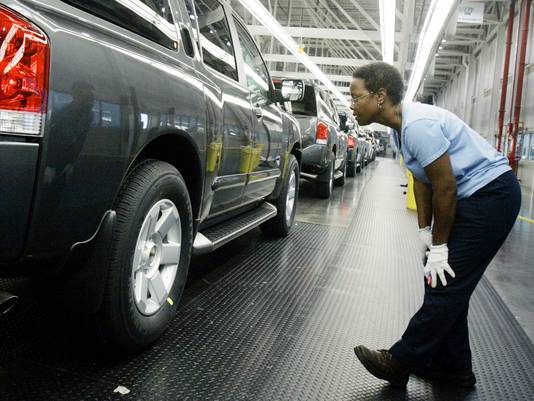Why United Auto Workers Union Czar Bob King Is Targeting Casino Employees

Today, roughly 800,000 Americans hold jobs with open shop auto and auto-parts makers. They prove you can still make money building cars and trucks in the U.S. And their jobs are located mostly in Right to Work states. Image: Rogelio Solis/AP
As Reuters reported earlier this week (see the news article linked above), United Auto Workers (UAW/AFL-CIO) union chieftain Bob King is now publicly suggesting his operation can survive and thrive in the future simply by acquiring “exclusive” bargaining control over additional employees in sectors like gambling, health care, and higher education. Â Basically contradicting what he has said in the past, King claims his success as the UAW’s top boss shouldn’t be gauged by his and his lieutenants’ ability to persuade currently union-free auto and auto-parts manufacturing workers to sign up with the UAW.
It’s understandable why King doesn’t want to raise expectations about UAW organizers’ ability to sell the union to open-shop factory workers. Â The UAW brass has tried to do this for decades, with nothing to show for it. Â And there is little reason to expect the UAW’s miserable record to change in the foreseeable future. Â Unfortunately, the Reuters story doesn’t try to explain why independent workers have been and remain so unreceptive to the UAW union message.
There are a number of likely reasons why, but one stands out in today’s anemic economy. Â The fact is, whenever the UAW launches a drive to acquire monopoly-bargaining privileges at a factory, employees are likely to find out that UAW “representation” is strongly correlated with loss of employment.
Data compiled and published (on the unionstats.com web site) by economists Barry Hirsch and David Macpherson show that, from 2002 to 2012, the number of unionized jobs in motor vehicle and motor vehicle equipment manufacturing fell by nearly half, from 413,000 to 208,000. Â Meanwhile, the number of union-free jobs in the sector actually increased, from 750,000 to 802,000.
King and his cohorts may well have hoped until recently that the billions and billions of dollars in taxpayer money that the George W. Bush and Barack Obama presidential administrations have poured into UAW-controlled automakers GM and Chrysler since 2009 would reverse the trend.
But the latest annual data from Hirsch and Macpherson show any such hopes would be empty. Â From 2011 to 2012 alone, unionized auto and auto-parts makers including bailed-out GM and Chrysler saw their collective employment fall from 224,ooo to 208,000, while nonunion jobs in the sector rose from 734,000 to 802,000.
UAW bosses and apologists for monopolistic unionism can concoct various scenarios to try to explain away the jobs data, but any factory employees who learn about them are likely to reach the logical conclusion that Big Labor’s hate-the-boss class warfare and knee-jerk opposition to changes in how autos, trucks and automotive parts are made ultimately undermine their job security. Â Meanwhile, in the casino, health care and university sectors, the UAW union elite has yet to establish such a horrendous track record.

